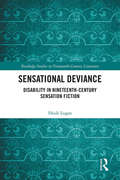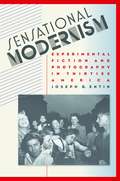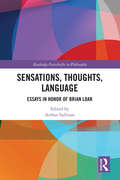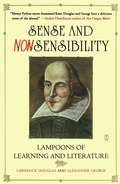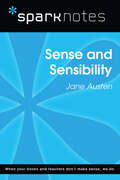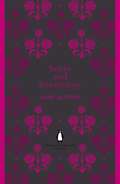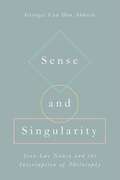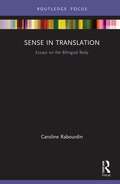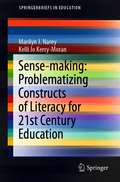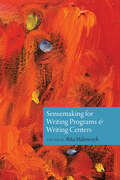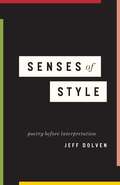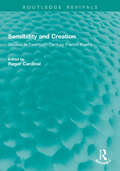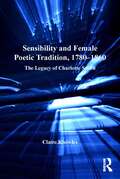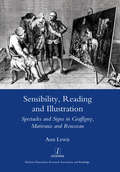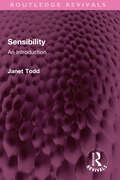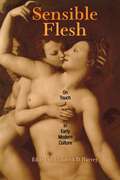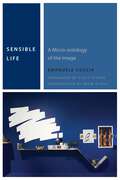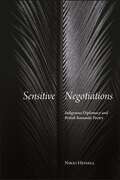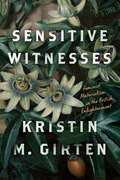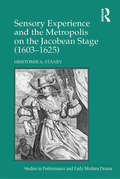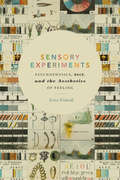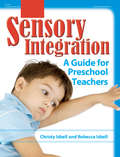- Table View
- List View
Sensational Deviance: Disability in Nineteenth-Century Sensation Fiction (Routledge Studies in Nineteenth Century Literature)
by Heidi LoganSensational Deviance: Disability in Nineteenth-Century Sensation Fiction investigates the representation of disability in fictional works by the leading Victorian sensation novelists Wilkie Collins and Mary Elizabeth Braddon, exploring how disability acts as a major element in the shaping of the sensation novel genre and how various sensation novels respond to traditional viewpoints of disability and to new developments in physiological and psychiatric knowledge. The depictions of disabled characters in sensation fiction frequently deviate strongly from typical depictions of disability in mainstream Victorian literature, undermining its stigmatized positioning as tragic deficit, severe limitation, or pathology. Close readings of nine individual novels situate their investigations of physical, sensory, and cognitive disabilities against the period’s disability discourses and interest in senses, perception, stimuli, the nervous system, and the hereditability of impairments. The importance of moral insanity and degeneration theory within sensation fiction connect the genre with criminal anthropology, suggesting the genre’s further significance in the light of the later emergence of eugenics, psychoanalysis, and genetics.
Sensational Modernism
by Joseph B. EntinChallenging the conventional wisdom that the 1930s were dominated by literary and photographic realism, Sensational Modernism uncovers a rich vein of experimental work by politically progressive artists. Examining images by photographers such as Weegee and Aaron Siskind and fiction by writers such as William Carlos Williams, Richard Wright, Tillie Olsen, and Pietro di Donato, Joseph Entin argues that these artists drew attention to the country's most vulnerable residents by using what he calls an "aesthetic of astonishment," focused on startling, graphic images of pain, injury, and prejudice. Traditional portrayals of the poor depicted stoic, passive figures of sentimental suffering or degraded but potentially threatening figures in need of supervision. Sensational modernists sought to shock middle-class audiences into new ways of seeing the nation's impoverished and outcast populations. The striking images these artists created, often taking the form of contorted or disfigured bodies drawn from the realm of the tabloids, pulp magazines, and cinema, represented a bold, experimental form of social aesthetics. Entin argues that these artists created a willfully unorthodox brand of vernacular modernism in which formal avant-garde innovations were used to delineate the conditions, contradictions, and pressures of life on the nation's fringes.
Sensations, Thoughts, Language: Essays in Honour of Brian Loar (Routledge Festschrifts in Philosophy)
by Arthur SullivanBrian Loar (1939-2014) was an eminent and highly respected philosopher of mind and language. He was at the forefront of several different field-defining debates between the 1970s and the 2000s—from his earliest work on reducing semantics to psychology, through debates about reference, functionalism, externalism, and the nature of intentionality, to his most enduringly influential work on the explanatory gap between consciousness and neurons. Loar is widely credited with having developed the most comprehensive functionalist account of certain aspects of the mind, and his ‘phenomenal content strategy’ is arguably one of the most significant developments on the ancient mind/body problem. This volume of essays honours the entirety of Loar’s wide-ranging philosophical career. It features sixteen original essays from influential figures in the fields of philosophy of language and philosophy of mind, including those who worked with and were taught by Loar. The essays are divided into three thematic sections covering Loar’s work in philosophy of language, especially the relations between semantics and psychology (1970s-80s), on content in the philosophy of mind (1980s-90s), and on the metaphysics of intentionality and consciousness (1990s and beyond). Taken together, this book is a fitting tribute to one of the leading minds of the latter-20th century, and a timely reflection on Loar’s enduring influence on the philosophy of mind and language.
Sense and Nonsense: A Study in Human Communication
by Alfred FleishmanA book on semantics and how to improve general communication.
Sense and Nonsensibility
by Lawrence Douglas Alexander GeorgeTwo widely published humor columnists and "bad boys" of academia take their wit and wisdom to dazzling new lows in this irreverent send-up of highbrow literary culture. At last, the thinking person's take on the life of the mind in today's increasingly mindless age. Sense and Nonsensibility pokes fun at everyone from spoof-proof scholars to pompous professors; from anal-retentive authors to plagiarizing poets; from snake-oil therapists to bestselling illiterati. This singular collection by Professors Lawrence Douglas and Alexander George brings together their most popular pieces, along with many brand-new ones, including: The Academy Awards for novels -- with categories for "Best Female Protagonist -- Doomed," "Best Narrator -- Unreliable," and "Best Novel -- Unfinishable by Reader" Home Shopping University -- offering the greatest ideas in Western history at rock-bottom prices I'm Okay, I'm Okay: Accepting Narcissism -- the best in "Self-helplessness books" The Penis Orations -- Iron Man's answer to The Vagina Monologues "Ask the Academic Ethicist" -- their notorious advice column, which has shocked higher education
Sense and Sensibility (SparkNotes Literature Guide Series)
by SparkNotesSense and Sensibility (SparkNotes Literature Guide) by Jane Austen Making the reading experience fun! Created by Harvard students for students everywhere, SparkNotes is a new breed of study guide: smarter, better, faster. Geared to what today's students need to know, SparkNotes provides: *Chapter-by-chapter analysis *Explanations of key themes, motifs, and symbols *A review quiz and essay topicsLively and accessible, these guides are perfect for late-night studying and writing papers
Sense and Sensibility (The Penguin English Library)
by Jane Austen"The more I know of the world, the more am I convinced that I shall never see a man whom I can really love. I require so much!"Jane Austen's novel tells the story of Marianne Dashwood, who wears her heart on her sleeve, and when she falls in love with the dashing but unsuitable John Willoughby she ignores her sister Elinor's warning that her impulsive behaviour leaves her open to gossip and innuendo. Meanwhile Elinor, always sensitive to social convention, is struggling to conceal her own romantic disappointment, even from those closest to her. Through their parallel experience of love - and its threatened loss - the sisters learn that sense must mix with sensibility if they are to find personal happiness in a society where status and money govern the rules of love.The Penguin English Library - 100 editions of the best fiction in English, from the eighteenth century and the very first novels to the beginning of the First World War.
Sense and Singularity: Jean-Luc Nancy and the Interruption of Philosophy
by Georges Van Den AbbeelePhilosophical thinking is interrupted by the finitude of what cannot be named, on the one hand, and that within which it is subsumed as one of multiple modes of sense-making, on the other. Sense and Singularity elaborates Jean-Luc Nancy’s philosophical project as an inquiry into the limits or finitude of philosophy itself, where it is interrupted, and as a practice of critical intervention where philosophy serves to interrupt otherwise unquestioned ways of thinking. Nancy’s interruption of philosophy, Van Den Abbeele argues, reveals the limits of what philosophy is and what it can do, its apocalyptic end and its endless renewal, its Sisyphean interruption between the bounds of infinitely replicating sense and the conceptual vanishing point that is singularity. In examinations of Nancy’s foundational rereading of Descartes's cogito as iterative, his formal experimentations with the genres of philosophical writing, the account of “retreat” in understanding the political, and the interruptive play of sense and singularity in writings on the body, sexuality, and aesthetics, Van Den Abbeele offers a fresh account of one of our major thinkers as well as a provocative inquiry into what philosophy can do.
Sense in Translation: Essays on the Bilingual Body (Routledge Advances in Translation and Interpreting Studies)
by Caroline RabourdinThis innovative and interdisciplinary work brings together six essays which explore the complex relationship between linguistic translation and spatial translation and argue for an understanding of linguistic translation as an embodied phenomenon. Integrating perspectives from philosophy, multilingual poetry and literature, as well as science and geometry, the book begins with a reading of translators Donald A. Landes’ and Richard Howard’s own notes on the translation and interpretation of the French words sens and langue. In the essays that follow, Rabourdin intertwines insights from both phenomenology and translation studies, engaging in notions of space, body, sense, and language as filtered through a multilingual lens and drawing on a diversity of sources, including work from such figures as Jacques Derrida, Maurice Merleau-Ponty, Henri Poincaré, Michel Butor, Caroline Bergvall, Jean-Jacques Lecercle, Louis Wolfson and Lisa Robertson. This interdisciplinary thematic perspective highlights the need for an understanding of the experience of translation as neither distinctly linguistic or spatial but one which fluidly allows for the bilingual body to sense and make sense. This book offers a unique contribution to translation studies, comparative literature, French studies, and philosophy of language and will be of particular interest to students and scholars in these fields.
Sense-making: Problematizing Constructs of Literacy for 21st Century Education (SpringerBriefs in Education)
by Marilyn J. Narey Kelli Jo Kerry-MoranThis book is a rich, yet highly accessible volume that details an exciting and much-needed inquiry into the notion of literacy: what it is, why it is, and how it might be framed most effectively for 21st century education. The chapters unfold in a creative interplay of practice and theory. Narey’s insightful questioning into the socio-historical-cultural implications of “literacy as empowerment” establishes the critical context, while Kerry-Moran’s examination of the burgeoning literacy landscape reveals challenges for teacher education. Drawing upon classic and cutting-edge theories, Narey builds a provocative and powerful case for a 21st century construct of literacy as sense-making: sense as relative to the senses (i.e., sight, hearing) and sense as making meaning. Her innovative model of the literacy event opens up a range of potential foci for analysis and facilitates her teasing out of two critical areas for instruction: sensory perception and aesthetic knowledge. This theoretical sense-making lens is applied to Kerry-Moran’s teacher education classroom as the authors reflect upon further development. As a timely original and thought-provoking work, this slim volume of big ideas promises to be a valuable resource for teacher educators and other scholars who seek a clear and cohesive frame for literacy in 21st century education. This is a very well written scholarly text that provides a new and important theory of 21st century literacy. Narey’s sketches of literacy as sense-making are laid out in logical form, building upon researched and referenced sources to ground her ideas and offering the reader information, examples and new insights. In addition to providing many significant perspectives underpinning her new theory, Narey provides excellent historical and current explanations about literacy from highly respected researchers in the field. The inclusion of a practical application of Narey’s conceptual/theoretical framework to Kerry-Moran's example of an instructional unit in a teacher education course is helpful to understanding the theory in practice. The references throughout the work are extensive, comprehensive and very well documented. This text, Sense-making: Problematizing Constructs of Literacy for 21st Century Education, contributes original thinking to the field of literacy and learning and would be an excellent resource for literacy and language professors or instructors in a post-graduate or professional development program.Penny Silvers, Professor of Education, Dominican University, USA
Sensemaking for Writing Programs and Writing Centers
by Rita MalenczykIn this collection writing program and writing center administrators from a range of academic institutions come together to explore their work through the lens of sensemaking. Sensemaking is an organizational theory concept that enables institutions, supervisors, teachers, tutors, and others to better understand the work they do by using narrative, metaphor, and other theoretical lenses. The book is divided into two sections: Sensemaking with Tutors and Teachers, and Sensemaking and Institutional Structures. Chapter authors employ several theoretical approaches to sensemaking, ranging from individual experience to institutional history to document design, providing readers with ideas for how to administer and teach within their programs more effectively; how to advocate for their programs within larger university contexts; and how to positively influence the lives and careers of those they work with. Sensemaking for Writing Programs and Writing Centers theorizes daily experiences from working lives and suggests problem-solving strategies. Writing program administrators, writing department chairs, and writing center directors, tutors, and staff will find value in its pages.
Senses of Style: Poetry before Interpretation
by Jeff DolvenIn an age of interpretation, style eludes criticism. Yet it does so much tacit work: telling time, telling us apart, telling us who we are. What does style have to do with form, history, meaning, our moment’s favored categories? What do we miss when we look right through it? Senses of Style essays an answer. An experiment in criticism, crossing four hundred years and composed of nearly four hundred brief, aphoristic remarks, it is a book of theory steeped in examples, drawn from the works and lives of two men: Sir Thomas Wyatt, poet and diplomat in the court of Henry VIII, and his admirer Frank O’Hara, the midcentury American poet, curator, and boulevardier. Starting with puzzle of why Wyatt’s work spoke so powerfully to O’Hara across the centuries, Jeff Dolven ultimately explains what we talk about when we talk about style, whether in the sixteenth century, the twentieth, or the twenty-first.
Sensibility and Creation: Studies in Twentieth-Century French Poetry (Routledge Revivals)
by Roger CardinalSensibility and Creation (1977) comprises a dozen critical studies by different contributors on a selection of major French poets of the twentieth century. These range from poets of long-established reputation, such as Paul Valéry, Pierre Reverdy, Saint-John Perse and Paul Eluard, to contemporary poets such as Yves Bonnefoy and Jacques Dupin. The guiding theme is that of the characteristic sensibility which informs the creative work of each poet: the way he has of selecting and patterning the elements which make up the world he inhabits and which in a sense he is also creating. In some instances the poetry is examined for its selective textures and shapes, and in others the critical focus is more closely directed to the linguistic and stylistic strategies adopted by the writer.
Sensibility and Female Poetic Tradition, 1780–1860: The Legacy of Charlotte Smith
by Claire KnowlesArguing that the end of the eighteenth-century witnessed the emergence of an important female poetic tradition, Claire Knowles analyzes the poetry of several key women writing between 1780 and 1860. Knowles provides important context by demonstrating the influence of the Della Cruscans in exposing the constructed and performative nature of the trope of sensibility, a revelation that was met with critical hostility by a literary culture that valorised sincerity. This sets the stage for Charlotte Smith, who pioneers an autobiographical approach to poetic production that places increased emphasis on the connection between the poet's physical body and her body of work. Knowles shows the poets Susan Evance, Letitia Elizabeth Landon, and Elizabeth Barrett-Browning advancing Smith's poetic strategy as they seek to elicit a powerful sympathetic response from readers by highlighting a connection between their actual suffering and the production of poetry. From this environment, a specific tradition in female poetry arises that is identifiable in the work of twentieth-century writers like Sylvia Plath and continues to pertain today. Alongside this new understanding of poetic tradition, Knowles provides an innovative account of the central role of women writers to an emergent late eighteenth-century mass literary culture and traces a crucial discursive shift that takes place in poetic production during this period. She argues that the movement away from the passionate discourse of sensibility in the late eighteenth century to the more contained rhetoric of sentimentality in the early nineteenth had an enormous effect, not only on female poets but also on British literary culture as a whole.
Sensibility, Reading and Illustration: Spectacles and Signs in Graffigny, Marivaux and Rousseau
by Ann Lewis"Eighteenth-century sensibilite has always been controversial. In fact, the term itself refers to complex forms of physical and emotional responsiveness, and Lewis's study investigates the fictional exploration of various key problems of sentimental response that were at the heart of eighteenth-century moral, epistemological and aesthetic debates. These are analysed in conjunction with some of the actual (often emotional) responses that the term, its fictions and images have provoked through time, including an indispensable survey of the varying construction of sensibilite as an object of study, and the polemics subtending its definition. The verbal evocation of the visual in the form of 'spectacles' and 'signs' was understood in the eighteenth century as having an especially powerful impact. Lewis provides a new reading of the theme of sensibility by analysing the 'textual images' in three best-selling novels from the mid-century: Graffigny's Lettres d'une Peruvienne, Marivaux's La Vie de Marianne and Rousseau's Julie. The examination of a largely neglected corpus of illustrations, understood as readings of each text, provides striking new evidence of the complexity, thematic richness and duplicity of these spectacles, whose power to provoke different reactions is perhaps their most interesting characteristic."
Sensibility: An Introduction (Routledge Revivals)
by Janet ToddThe cult of sensibility jangled the nerves of Europe in the mid-eighteenth century. It touched all literary genres and brought into prominence those qualities of tenderness, compassion, sympathy and irrational benevolence associated with women by the binary psychology of the time. It privileged spontaneous emotion and found this expressed in the bodily manifestations of tears, fainting fits, flushes and palpitations. Valuing the pure victim, it took as its archetypes the innocent dying Clarissa and the benevolent, suffering man of feeling.In Sensibility, originally published in 1986, Janet Todd charts the growth and decline of sentimental writing as a privileged mode in the eighteenth century. She shows how sentimental writing is riven with contradictions: while it applauds fellowship, it also expresses a yearning for isolation, and while it stresses the ties of friendship and family, it does so at the expense of sexual feeling, which grows menacing and destructive.By the 1770s, as the idea of sensibility was losing ground, ‘sentimentality’ came in as a pejorative term. Janet Todd ends her study of sensibility by detailing the various attacks on the cult, from radicals and conservatives, feminists and Christian moralists; from Coleridge who saw it as unmanning the nation to Jane Austen who considered it an elaborate sham
Sensible Flesh: On Touch in Early Modern Culture
by Elizabeth D. HarveyThis ground-breaking interdisciplinary collection explores the complex, ambiguous, and contradictory sense of touch in early modern culture. If touch is the sense that mediates between the body of the subject and the world, these essays make apparent the frequently disregarded lexicons of tactility that lie behind and beneath early modern discursive constructions of eroticism, knowledge, and art. For the early moderns, touch was the earliest and most fundamental sense. Frequently aligned with bodily pleasure and sensuality, it was suspect; at the same time, it was associated with the authoritative disciplines of science and medicine, and even with religious knowledge and artistic creativity.The unifying impulse of Sensible Flesh is both analytic and recuperative. It attempts to chart the important history of the sense of touch at a pivotal juncture and to understand how tactility has organized knowledge and defined human subjectivity. The contributors examine in theoretically sophisticated ways both the history of the hierarchical ordering of the senses and the philosophical and cultural consequences that derive from it.The essays consider such topics as New World contact, the eroticism of Renaissance architecture, the Enclosure Acts in England, plague, the clitoris and anatomical authority, Pygmalion, and the language of tactility in early modern theater. In exploring the often repudiated or forgotten sense of touch, the essays insistently reveal both the world of sensation that subtends early modern culture and the corporeal foundations of language and subjectivity.
Sensible Life: A Micro-ontology of the Image (Commonalities)
by Emanuele CocciaWe like to imagine ourselves as rational beings who think and speak, yet to live means first and foremost to look, taste, feel, or smell the world around us. But sensibility is not just a faculty: We are sensible objects both to ourselves and to others, and our life is through and through a sensible life.This book, now translated into five languages, rehabilitates sensible existence from its marginalization at the hands of modern philosophy, theology, and politics. Coccia begins by defining the ontological status of images. Not just an internal modification of our consciousness, an image has an intermediate ontological status that differs from that of objects or subjects. The book’s second part explores our interactions with images in dream, fashion, and biological facts like growth and generation. Our life, Coccia argues, is the life of images.
Sensitive Negotiations: Indigenous Diplomacy and British Romantic Poetry (SUNY series, Studies in the Long Nineteenth Century)
by Nikki HessellThroughout the nineteenth and early twentieth centuries, Indigenous peoples in North America and the Pacific engaged with the latest and most fashionable British Romantic poetry as part of transcontinental and transoceanic cross-cultural negotiations about sovereignty, treaty rights, and land claims. In Sensitive Negotiations, Nikki Hessell uses examples from North America, Africa, and the Pacific to show how these Indigenous figures quoted lines from famous poets like Lord Byron and Felicia Hemans to build sympathy and community with their audience. Hessell makes new connections by setting aside European-derived genre barriers to bring literary studies to bear on the study of diplomacy and scholarship from diplomatic history and Indigenous studies to bear on literary criticism. By connecting British Romantic poetry with Indigenous diplomatic texts, artefacts, and rituals, Hessell reimagines poetry as diplomatic and diplomacy as poetic.
Sensitive Pasts: Questioning Heritage in Education (Making Sense of History #27)
by Maria Grever Carla Van Boxtel Stephan KleinHeritage, as an area of research and learning, often deals with difficult historical questions, due to the strong emotions and political commitments that are often at stake. In this, it poses particular challenges for teachers, museum educators and the publics they serve. Guided by a shared focus on these “sensitive pasts,” the contributors to this volume draw on new theoretical and empirical research to provide valuable insights into heritage pedagogy. Together they demonstrate the potential of heritage as a historical-educational domain that transcends myopic patriotism, parochialism and simplistic relativism, helping to enhance critical and sophisticated historical thinking.
Sensitive Reading: The Pleasures of South Asian Literature in Translation
by Yigal Bronner and Charles HalliseyA free open access ebook is available upon publication. Learn more at www.luminosoa.org. What are the pleasures of reading translations of South Asian literature and what does it take to enjoy them? This volume explores these questions by bringing together a whole set of new translations by David Shulman, noted scholar of South Asia. The translated selections come from a variety of Indian languages, genres, and periods, from classical to current. They are accompanied by short essays especially written to help readers engage and enjoy them. Some of these essays provide background to enhance any reading of the translation while others model how to expand appreciation in broader and comparative ways. Taken together, the translations and the accompanying essays form an essential guide for people interested in literature and art from South Asia.
Sensitive Witnesses: Feminist Materialism in the British Enlightenment
by Kristin M. GirtenKristin M. Girten tells a new story of feminist knowledge-making in the Enlightenment era by exploring the British female philosophers who asserted their authority through the celebration of profoundly embodied observations, experiences, and experiments. This book explores the feminist materialist practice of sensitive witnessing, establishing an alternate history of the emergence of the scientific method in the eighteenth century. Francis Bacon and other male natural philosophers regularly downplayed the embodied nature of their observations. They presented themselves as modest witnesses, detached from their environment and entitled to the domination and exploitation of it. In contrast, the author-philosophers that Girten takes up asserted themselves as intimately entangled with matter—boldly embracing their perceived close association with the material world as women. Girten shows how Lucy Hutchinson, Margaret Cavendish, Aphra Behn, Eliza Haywood, and Charlotte Smith took inspiration from materialist principles to challenge widely accepted "modest" conventions for practicing and communicating philosophy. Forerunners of the feminist materialism of today, these thinkers recognized the kinship of human and nonhuman nature and suggested a more accessible, inclusive version of science. Girten persuasively argues that our understanding of Enlightenment thought must take into account these sensitive witnesses' visions of an alternative scientific method informed by profound closeness with the natural world.
Sensory Experience and the Metropolis on the Jacobean Stage (Studies In Performance And Early Modern Drama Ser.)
by Hristomir A. StanevAt the turn of the seventeenth century, Hristomir Stanev argues, ideas about the senses became part of a dramatic and literary tradition in England, concerned with the impact of metropolitan culture. Drawing upon an archive of early modern dramatic and prose writings, and on recent interdisciplinary studies of sensory perception, Stanev here investigates representations of the five senses in Jacobean plays in relationship to metropolitan environments. He traces the significance of under-examined concerns about urban life that emerge in micro-histories of performance and engage the (in)voluntary and sometimes pre-rational participation of the five senses. With a dominant focus on sensation, he argues further for drama’s particular place in expanding the field of social perception around otherwise less tractable urban phenomena, such as suburban formation, environmental and noise pollution, epidemic disease, and the impact of built-in city space. The study focuses on ideas about the senses on stage but also, to the extent possible, explores surviving accounts of the sensory nature of playhouses. The chapters progress from the lower order of the senses (taste and smell) to the higher (hearing and vision) before considering the anomalous sense of touch in Platonic terms. The plays considered include five city comedies, a romance, and two historical tragedies; playwrights whose work is covered include Shakespeare, Jonson, Webster, Fletcher, Dekker, and Middleton. Ultimately, Stanev highlights the instrumental role of sensory flux and instability in recognizing the uneasy manner in which the London writers, and perhaps many of their contemporaries, approached the rapidly evolving metropolitan environment during the reign of King James I.
Sensory Experiments: Psychophysics, Race, and the Aesthetics of Feeling
by Erica FretwellIn Sensory Experiments, Erica Fretwell excavates the nineteenth-century science of psychophysics and its theorizations of sensation to examine the cultural and aesthetic landscape of feeling in nineteenth-century America. Fretwell demonstrates how psychophysics—a scientific movement originating in Germany and dedicated to the empirical study of sensory experience—shifted the understandings of feeling from the epistemology of sentiment to the phenomenological terrain of lived experience. Through analyses of medical case studies, spirit photographs, perfumes, music theory, recipes, and the work of canonical figures ranging from Kate Chopin and Pauline Hopkins to James Weldon Johnson and Emily Dickinson, Fretwell outlines how the five senses became important elements in the biopolitical work of constructing human difference along the lines of race, gender, and ability. In its entanglement with social difference, psychophysics contributed to the racialization of aesthetics while sketching out possibilities for alternate modes of being over and against the figure of the bourgeois liberal individual. Although psychophysics has largely been forgotten, Fretwell demonstrates that its importance to shaping social order through scientific notions of sensation is central to contemporary theories of new materialism, posthumanism, aesthetics, and affect theory.
Sensory Integration: A Guide for Preschool Teachers
by Rebecca Isbell Christy IsbellDo you have a child in your early childhood classroom who:*Climbs on top of furniture and jumps off? *Covers his ears when children are singing? *Refuses to touch clay, paint, or sand? *Often falls down and skins her knees? *Refuses to play on outdoor playground equipment?If so, it is possible the child is having sensory processing problems. How can you help children with these problems so they can enjoy learning and grow in positive ways? Sensory Integration helps you identify children who have difficulties with sensory processing, and it offers simple, easy-to-use solutions to support the sensory needs of young children in the preschool classroom. Easy-to-implement solutions include adaptations and activities for children with different types of Sensory Processing Disorder. This book has a bonus chapter with instructions for creating low-cost items to help children with sensory issues.Chapters cover concepts such as:*Explaining Sensory Integration and Sensory Processing Disorder*Defining sensory avoiders, seekers, and under-responders*Designing the environment to support the sensory development of all children*Helping preschoolers with sensory processing problems*Providing practical solutions to meet the needs of individual children during daily routines*Building and creating low-cost items such as a tire swing, sand pillow, and incline board to give children opportunities to get the sensory input they need
